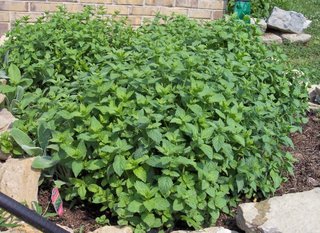 August is vacation month for a lot of people. Some things to remember if you are planning to be away for more than a week.
August is vacation month for a lot of people. Some things to remember if you are planning to be away for more than a week.1-Weed your gardens before you go, if you have weeds.
2-Pinch any blooms that are showing to encourage continued growth.
3-Water abundantly, herbs will be fine for a week or longer without water if you give them a good soaking.
4-If you have a problem with any pest, do whatever treatment you are applying before you go away.(and hope for the best when you return) Pest can get out of hand in one day, so a week is a long time to be left to feast.
Now, if you are staying home some things you can be performing in the herb gardens this month are:
Rosemary, Mints and Sage can be propagated now.
As you can see from the rosemary shrubs above they have very long stems.
Lay a stem on the ground as close to the bottom of the plant as you can get, just pull it over and hold it to the ground.(don't break it from the mother plant. Instead, clamp it to the ground with a garden staple( looks like a very large hairpin.) Push it down over the stem and it should be secure to the soil.
Apply a thin layer of good compost to the spot you stapled.
Water and in a day or so add some extra compost and water again.
In a few weeks or so the arm will have rooted. Cut it from the mother plant just above the stapled section. You can now dig up the new plant and re-plant in a new location or pot it and leave for next spring.
Mints can be taken up by the root or simply broken off and rooted in good compost.
Leave your mints in the pot until spring and you will have hardy transplants to start the season with.
If you have already cut your Sage back you are seeing new shoots cropping out by now.
You can break or cut these from the mother plant and pot the same as mint or plant then directly in the ground where you wish them to grow.
Sage is cold hardy and will survive the winter.
Sage is also one of those herbs that tends to get very woody stems after about the second or third year and needs to be replaced for the best results.
All other herbs should still be producing, although they are no doubt starting to flower, herb blooms are edible and look and taste great in salads and vegetables. They can also be dried right along with the leaves.
Don't forget too, they make an awesome summer flower arrangement for the table.
I hope you are saving all your compost material for your fall production. Grass clippings, shredded limbs, dead plants(no diseased ones) vegetable peels and coffee and tea grinds along with your eggshells. ( remember, never put cooked food or any meat products into your compost, it will turn rancid and spoil the entire pile.
Have an Awesome August and happy gardening!
Bea Kunz
http://www.sagehillfarmsandvintagestore.com



